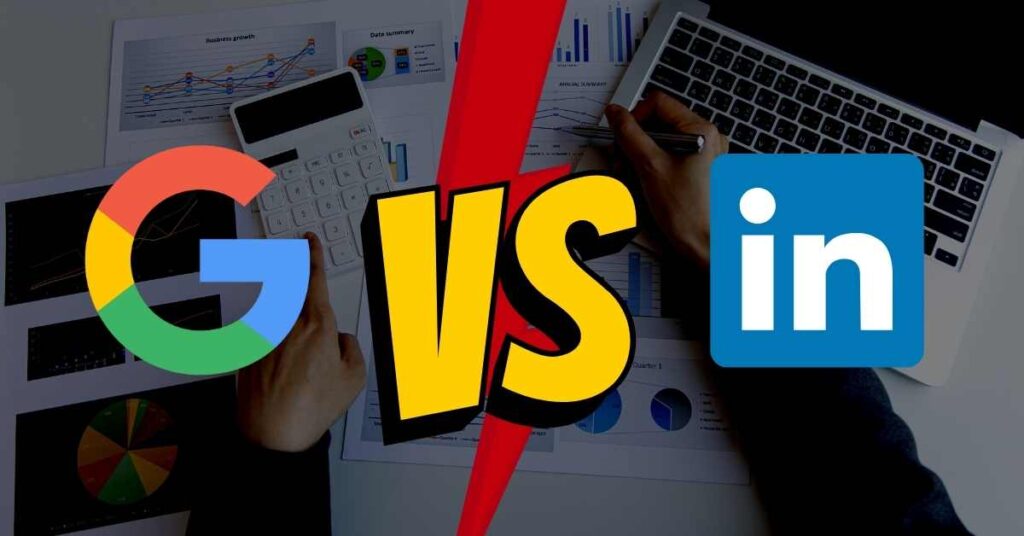One common question we get here at Louder when we’re talking to B2B businesses is whether they should be looking at LinkedIn or Google as their core advertising platform.
It’s a very good question, as both platforms do a fantastic job in driving targeted traffic to B2B offers (albeit in different ways), and both have great support for attribution (the technical ability to track results from ads). Many businesses will do well being on both platforms.
However, when you pit one against the other, a few considerations emerge that might sway your decision.
What are Google Ads?
Google Ads (formally Google AdWords) is one of the longest-running platforms for online advertising. Google Ads can run across the majority of Google-operated services, including Google Search, Google Shopping, YouTube, and Gmail.
With billions using Google every day, there’s a huge opportunity to get your business in front of your ideal potential customers. When we refer to using Google Ads for B2B businesses, we’re usually referring to PPC (Pay-Per-Click) advertising on Google Search which allows advertisers to appear for specific search terms, however, we often run additional remarketing & branding campaigns across the other Google services which further help support the core campaigns.
What is LinkedIn Advertising?
LinkedIn, which hardly needs an introduction, has allowed advertising on its platform since the mid-2000’s. LinkedIn ads can take the form of sponsored updates, carousel ads, message ads (previously sponsored InMail) and more.
LinkedIn has two options available for how they bill advertisers, CPC & CPM.
CPC bidding will charge you per click on your ads, while with CPM bidding you’ll be charged based on the number of users who have seen it (impressions).
What’s the best feature of Google Ads?
The biggest reason to use Google Ads comes down to the ability to directly tap into users’ ‘buyer-intent’, as well as make use of the PPC model.
When we talk about buyer-intent, we’re referring to a prospect’s current location in the sales funnel. Buyer-intent is a stage that lies at the very bottom of the funnel, well past the education stage. It is where people actively search for a solution to whatever problem they have.
With the ability to target specific search terms and a bit of research, advertisers on Google can position themselves prominently at the bottom of the sales funnel, ready to pick up people who are on the cusp of becoming customers. In some cases, even poaching pre-warmed prospects off of competitors.
And with the PPC (Pay-Per-Click) nature of Google Search Ads, advertisers can rest assured that they will only be charged when someone shows enough interest in their offer to click and learn more. The price you end up paying per click is determined by what other competitors are willing to pay for clicks to that keyword – an auction if you like.
The combination of these two things makes Google Ads a high-revenue generating marketing platform for many businesses, and one that can turn around a profit quickly.
What’s the best feature of LinkedIn Ads?
The most valuable feature of B2B LinkedIn advertising is its targeting options and audience creation tools. Because of the corporate culture of LinkedIn, the platform has heaps of job/career data for every user on the platform. Everything from a user’s current company to their current role within that company, to their past employment history, demographics, and their interests.
This makes the LinkedIn Ads platform a powerhouse for B2B companies that understand who their offering is most going to appeal to. For businesses that want to target a specific type of worker, it is unrivaled as a marketing platform.
Again, like Google, LinkedIn has both PPC and CPM options available across the different ad types.
Are there any drawbacks to Google Ads and LinkedIn Ads?
As we’ve already mentioned, both Google and LinkedIn offer powerful marketing platforms for paid advertising. But like any platform, there are some limitations and potential drawbacks that might require some extra creativity to navigate.
For Google, it can sometimes be difficult to decipher the intent behind phrases used. A term may seem like a good choice for a keyword, until you discover through Google Analytics that it is in fact driving low visitor engagement metrics despite accurately describing what you offer. Trying to pinpoint the exact search terms your customers are using can also be a challenge, even with intimate in-depth knowledge of their personas, desires, and pain points.
The solution to this is straightforward but may take some time – test and experiment! Google offers a type of keyword called a ‘broad match’, which allows your ads to be shown for terms that Google deems similar to the keywords you manually provide. Google then provides you with all the terms that triggered your ads, so with a bit of time spent at the end of each week, you can effectively learn which terms you should add to the campaigns and which terms you should exclude.
Another drawback to Google Ads is the fact that because it primarily runs on a Pay-Per-Click model, it can be expensive to deploy ads for more top-of-the-funnel offers, such as something that sits in the brand-awareness or education stage. The reason for this, is that because of the high buyer-intent of Google searchers, the majority of advertisers on Google are pitching bottom-of-the-funnel offers, offers designed to quickly convert and create high conversion value. And as we mentioned earlier, the cost of a click is highly dependent on how much competitors are willing to pay for that click. High conversion offers bring with them higher cost per click prices for keywords, effectively pricing out those who want to advertise their top-of-the-funnel offers.
Saying this, top-of-the-funnel offers can do well on other Google services that work on CPM models, such as YouTube.
With LinkedIn on the other hand, you will have to accept that as a social media platform, there just isn’t the capability to target based on real-time search-intent, as there is with Google.
LinkedIn advertisers also need to be prepared to deal with a somewhat clunky user interface in the ads manager. It’s fair to say that with all the capabilities of modern advertising platforms, the backend management can sometimes be complex – however LinkedIn takes the cake when it comes to learning curve. Once you’ve got a few hours under your belt it does get easier, but for beginners to the platform, some of the ‘niggles’ can take some time to get the hang of. Of course, this obstacle is easily circumvented by utilising an expert in the platform.
LinkedIn also has less variety of ad campaign types than Google, due to everything existing within the main LinkedIn.com ecosystem. This is opposed to plenty of unique Google ad formats being available to utilise across all of the main Google services (YouTube, Gmail, Discover and more).
So which platform is right for me?
Both Google and LinkedIn are brilliant platforms, and most B2B businesses can utilise both to cover all stages of the sales funnel.
If you’re a startup, or you’re a company that is introducing a never-seen-before new product/service to the market, you’re probably going to be looking at the majority of your initial marketing budget going into brand awareness and education – in which LinkedIn would be a clear winner due to their CPM model. Of course, LinkedIn would also be the best choice for you if your business needs to reach people of a certain job role, or company size, due to having these kinds of options available to target within the platform.
If you’re a well-known company, or you’re offering a similar product to competitors (in which there is plenty of existing demand), then you’re probably going to benefit with running ads to bottom-of-the-funnel offers, in which case Google might be a good choice for you. This isn’t to say LinkedIn can’t also drive great results in this aspect – it absolutely can! However, Google’s unique ability to allow you to target by search term creates a huge advantage when the market is already familiar with your product or service.
As you’re probably starting to realise, there is no clear blanket answer for the Google vs LinkedIn debate. They are both great platforms that offer different use cases, and the most responsible thing we can say is that every business (along with all its unique variables and needs) should be analysed individually to determine the best course of action / budget allocation.






